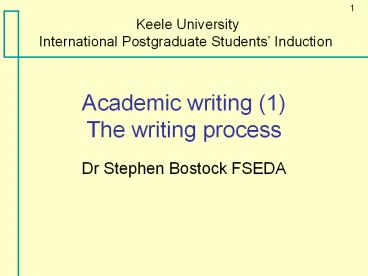Academic writing 1 The writing process - PowerPoint PPT Presentation
1 / 38
Title:
Academic writing 1 The writing process
Description:
Writing is an essential part of much academic work, including assessed work. ... a guide for students Second edition, Maidenhead: Open University Press ... – PowerPoint PPT presentation
Number of Views:6850
Avg rating:5.0/5.0
Title: Academic writing 1 The writing process
1
Academic writing (1)The writing process
Keele UniversityInternational Postgraduate
Students Induction
- Dr Stephen Bostock FSEDA
2
Summary
- Different ways of writing
- Writing as a process
- Prewriting reading and talking
- Planning
- Revising reviewing
- Editing
3
Academic writing
- Writing is an essential part of much academic
work, including assessed work. - The product of other study activities like
research, note-making, reflection, goal setting. - There are different purposes and types of writing
but - All academic writing shares some features and
writing processes.
4
Your own writing process3
- There is no blueprint that works for everyone,
every time. - The diver writer
- The patchwork writer
- The grand plan writer
- The architect writer (Creme Lea, p.78)
5
How do you write?
- How do you typically organize your writing? Do
you use something like one of those methods? - Describe it now, in writing.
- What do you think are the advantages and
disadvantages of this method? - Write two lists now.
6
Practice writing in English
- Write privately in a learning journal
- To record important information
- To note ideas that you could use later
- To Do lists
- Write in sentences to
- Express reflections on things you learn and how
you could apply them - Practice paragraphs you can improve later
- Build a sense of yourself as a writer.
7
(No Transcript)
8
(No Transcript)
9
The writing process a modelbased on Coffin,
chapter 22
10
1. Prewriting1
- To find something to write about
- Understand, generate ideas
- Research, read, discuss
- Methods
- Brainstorming
- Freewriting
- Personal journal writing
11
The academic essayResearch the topic
- Read the right
- Books
- Periodicals
- Internet
12
Writing is not isolated
13
Freewriting now
14
2. Planning
- To clarify, focus, organize
- Methods include
- List
- Graphic organizers mind map, clustering
- Outline view (essay plan).
15
Cluster diagram4
16
Mind maps
17
Outline
18
(No Transcript)
19
3. and 4. Drafting and revision
- Whatever your process, good writing takes
- Time
- Work
- Revisions.
- Revisions can be made on the word processor
screen or on paper. - Leave time for revisions.
20
Revision example
21
(No Transcript)
22
(No Transcript)
23
Elements of writing
- Summarize
- Paraphrase
- Synthesize
- Analyze
- Evaluate
24
Summarize
25
Paraphrase
26
Synthesize
27
Analyze
28
Evaluate
29
Paraphrase or summary?
- Paraphrase To express the meaning in other
words - Summary or Abstract Containing the chief
points or sum or substance of a matter with
implication of brevity(Shorter Oxford English
Dictionary)
30
Exercise a summary
- Read the text provided and write a summary of
less than 100 words. - Do not include any of the original sentences or
phrases.
31
5. Peer review
- Peer review is an essential part of professional
academic life. - Anonymous peer reviews are necessary for journal
publication and some books. - Review by critical friends is common.
32
Support the revision
- Swap pieces of writing in pairs.
- Write on the review form to give helpful advice
to the author on their summary. - Hand back the writing with the review form.
33
In your own words 3
- Degrees are awarded to individual students for
demonstrating their own knowledge of a subject,
not just re-using existing knowledge. - But you need to read what authorities think and
compare your views with friends and colleagues. - Use a critical friend. Be a critical friend.
- Then write in your own words but citing where you
use someone elses ideas and quoting when you use
someone elses words.
34
Revise your summary
- Read the review form.
- Take note of its comments and address each one.
- Rewrite your summary on a new sheet
- Add your name at the top and hand it in at the
end of the session.
35
Tomorrow
- We will give general feedback.
- You will write a reflection on your summary and
writing style.
36
6. Editing
- Editing, proofreading polishing are to correct
the surface features of the text. - Appearance
- Formatting, fonts, footnotes, footers
- Linguistic accuracy
- Spelling, punctuation
- Sources, references, acknowledgements
- Citations correct, references complete
37
Visual clarity - formatting
- You may be given format guidelines.
- If not, ask a tutor for advice. E.g. what
spacing? What margins? - Title page student number, title, date, module,
course possibly word length. - Font use Arial 11 point, unless specified
otherwise headings sub-headings are a little
larger bold or italic use sparingly. - Footer page numbers, other information?
38
References
- Derek Soles, 2003, Writing an academic essay,
Studymates Coffin, C. et al. Teaching Academic
Writing 2003 London Routledge - In your own words is a web document by Mike
Brough - Further reading
- Stella Cottrell, 2003, The study skills handbook,
second edition, Palgrave - Creme, P. and Lea, R.L. 2003 Writing at
university, a guide for students Second edition,
Maidenhead Open University Press































